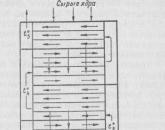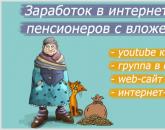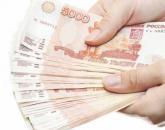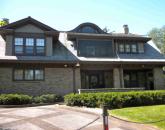Technology of visual-measuring methods for testing welds. Certificate for welding of the control joint Certificate of external inspection of welded joints
Document section: Sample Documents, Act
ACT No. _____ from __________ visual and/or measurement quality control welds during the welding process
________________________________________________________________________ (product name and connection number)
1. This act certifies the fact that the welder has fulfilled ______________________________________________________________________ full name, brand
Connections _________ (see welding list), connection type(s)
Completed by _________________________________________________________ indicate the method of welding and the position
In accordance with the requirements of the welding technology ______________________ ________________________________________________________________________ specify the technology code
And inaccessible to control __________________________________________ indicate the method of control prescribed
Design documentation
2. In case of layer-by-layer visual and measuring control with quality assessment according to the standards _____________________________________ for category ____________________________________________________________________________ (code or name of ND)
It has been established that the welded joint is recognized as fit and meets the requirements of __________________________________________________________ (specify RD or design documentation)
The control was carried out by: _________________________________________________ Level of qualification, Surname, initials, signature No. qualification certificate
Head of work on visual and measuring control: ______________________________________________________________ Surname, initials, signature
Note. The act is drawn up for each welded structure (joint or group of joints) subjected to control during the welding process.
Requirements for the execution of the "Protocol of dimensions _____________" (product)
The protocol of dimensions is drawn up only if it is indicated in the ND or PKD for the controlled product. The protocol of product dimensions (table) must contain the actual dimensions of the product, made in certain sections, which are specified by the "Measurement Scheme ____________". The form of the Protocol of dimensions is determined by (product)
During design and technological preparation control works. The protocol is signed by the persons who performed the measurements and the head of the work on visual and measurement control, indicating the surname and initials.
Requirements for the content of the "Journal of accounting for work
and registration of the results of visual
and measuring control"
The results of the control of products, products and objects are recorded in the "Journal of accounting for work and registration of the results of visual and measurement control", which indicates:
1) name and type (type) of the controlled object, its number or code;
2) the location and, if necessary, the size of the controlled areas at the control object;
3) conditions for conducting control;
4) production control document, its number;
5) the method of measuring control and the instruments (tools) used;
6) brand and batch number of the material of the object of control, as well as the designation of the standard or specifications on the material and drawing number of the object (the latter only for parts and assembly units);
7) the main characteristics of the defects identified during the inspection (shape, size, location or orientation relative to the base axes or inspection surfaces);
8) name or ND code, according to which the quality assessment was carried out;
9) assessment of control results;
10) date of control.
Note. It is allowed to use instead of the above other forms of documents developed by the organization in accordance with the requirements of the current regulatory and technical documentation, which provide identification and traceability of parts, assemblies, products in the manufacturing process (installation, repair), fixation of controlled parameters, volumes and methods of control, registration of reporting and accounting documentation for visual and measuring control.
Save this page.
font size
REGULATION of the Gosgortekhnadzor of the Russian Federation dated 11-06-2003 92 ON APPROVAL OF INSTRUCTIONS FOR VISUAL AND MEASURING CONTROL (2020) Relevant in 2018
ACT OF VISUAL AND/OR MEASURING QUALITY CONTROL OF WELDED SEAMS DURING JOINT WELDING
______________________ (organization) ACT N _____ from __________ visual and / or measuring quality control of welds in the process of welding a joint __________________________________________________________________ (product name and joint number) welding technology __________________ __________________________________________________________________ indicate the code of the technology and unavailable for control ______________________________________ indicate the method of control prescribed by __________________________________________________________________ design documentation _________________________________ Qualification level, Surname, initials, signature N of the qualification certificate Head of work on visual and measuring control: ____________________________________________________________ Surname, initials, signature Note. The act is drawn up for each welded structure (joint or group of joints) subjected to control during the welding process. Requirements for the execution of the "Dimension Protocol _____________" (product) The protocol of dimensions is drawn up only if it is indicated in the RD or PKD for the controlled product. The protocol of product dimensions (table) must contain the actual dimensions of the product, made in certain sections, which are specified by the "Measurement Scheme _____________". The form of the Protocol (product) of dimensions is determined during the design and technological preparation of control work. The protocol is signed by the persons who performed the measurements and the head of the work on visual and measurement control, indicating the surname and initials. Requirements for the content of the "Journal of accounting of work and registration of the results of visual and measurement control" The results of control of products, products and objects are recorded in the "Journal of accounting of work and registration of the results of visual and measurement control", which indicates: 1) the name and type (type) of the controlled object, its number or code; 2) the location and, if necessary, the size of the controlled areas at the control object; 3) conditions for conducting control; 4) production control document, its number; 5) the method of measuring control and the instruments (tools) used; 6) brand and batch number of the material of the control object, as well as the designation of the standard or technical specifications for the material and the drawing number of the object (the latter only for parts and assembly units); 7) the main characteristics of the defects identified during the inspection (shape, size, location or orientation relative to the base axes or inspection surfaces); 8) name or ND code, according to which the quality assessment was carried out; 9) assessment of control results; 10) date of control. Note. It is allowed to use instead of the given other forms of documents developed by the organization in accordance with the requirements of the current regulatory and technical documentation, which provide identification and traceability of parts, assemblies, products in the manufacturing process (installation, repair), fixation of controlled parameters, volumes and methods of control, execution of reporting and accounting documentation for visual and measurement control.
Weld control is a necessary part of the acceptance of various designs for operation. The methods and results of verification actions are reflected in a special act.
FILES
How to check welds
In fact, a variety of methods can be used to study welds, for example, ultrasonic, magnetic, chemical, capillary and other high-tech methods. However, the classic, to this day relevant and in demand - the usual visual inspection. Its purpose: to make sure that the seam is of high quality, well welded, has no undercuts, sagging, burns, excessive scaling and other flaws. The advantages of this type of study are quite obvious: it does not require large expenses, while it is accessible and quite informative, but along with this, there are also disadvantages: the subjectivity of the examination, low reliability, the ability to examine only the visible part of the seam.
Visual inspection can be carried out both with the naked eye (usually if we are talking about large, well-visible seams), and with the help of various devices, such as lenses, microscopes, endoscopes, flaw detectors, etc.
They are used to reveal the smallest hidden defects that are difficult to detect with a simple inspection of the outside of the weld (for example, microscopic cracks, nicks, delamination, fractures, etc.). At the same time, there are devices that are intended only for use in laboratories and those that can be used “in the fields”. The latter are able to withstand any temperature and weather conditions (including those that have an increased coefficient of radiation, chemical, bacteriological, etc. hazard to humans).
Why Weld Inspection is Necessary
The purpose of such an in-depth examination is quite obvious: as a rule, any structures that use welding are designed to withstand a certain, fairly serious load (especially for building structures). And any deviation from technical standards that occurred during their manufacture threatens that the structure will not withstand and break, which in turn can lead not only to financial losses, but also to a threat to life and health of people.
Often, welds are checked not only after the manufacture of the structure, but also during its operation - this is due to the fact that they can be subject to corrosion and other adverse effects. Also, regular checks are necessary when surfacing several layers on a worn structure, while each completed layer is controlled, the length of the seam, the thickness of the base metal are measured, and these data are compared with the established standard for this section, taking into account its load.
The frequency of inspections is determined by the norms of the law, as well as the internal regulations of the company.
Timely and high-quality visual inspections make it possible to detect the destruction of the seam as early as possible, as well as to understand the causes and find a way to eliminate them.
Who carries out the inspection and draws up the act
The initial check of the quality of the weld is done by the welder who performed it. Further control is carried out by other employees: for example, the site manager, engineer, etc. It is important that these persons have the necessary knowledge of the technique of visual inspection of welds, as well as be equipped with the necessary instruments and fixtures. They should also have an idea of how to form an act visual inspection welds.
Act format
Today there is no single standard of the act, which means that it can be done in any form. However, if the organization has its own document template, which is developed and approved by management, then it should be used. Well, if the format of the act is indicated in accounting policy enterprises.
Features of the execution of the act of visual inspection of welds
With regard to the execution of the act, no requirements are also put forward, that is, it can be written by hand or typed on a computer, a form with corporate logo and details and an ordinary piece of paper. The only thing: if an electronic form was made, then it should be printed out to put signatures in it responsible persons. The act is made in one original copy, which must be assigned a number.
Registration and storage of the act
Information about the act must be entered in a special register, in which it is enough to make a note about its number and date of creation. The period of storage of the finished act is determined by the administration of the enterprise individually, based on the norms established by law, as well as the internal needs of the company.
The act must be stored in a separate folder or in structural unit, in which it was formed, or in the archive of the organization.
If you need to draw up a weld inspection report that you have never done before, use the sample below and read the comments on it - they will help you make the required document without errors and ambiguities.
- First of all, enter the name of the enterprise into the act, then assign a number to the document, indicate the date and place of its creation.
- Next, enter in the act of position, the full name of the employees who inspected the weld (if they are representatives different enterprises, give the names of each).
- After that, go to the main part: include information about the performer of the work: position, full name, then enter information about welds that were examined: their number, steel grade and other identification values.
- Indicate the devices and devices that were used during the test, all the methods used, their results, and also give recommendations on additional methods of examination.
- At the end, be sure to sum up the current control, put signatures.
To assess the quality of welded joints, the concept of a control welded joint is established. A control weld is considered to be a welded joint that is identical to the controlled production welded joints: the steel grades of the elements to be joined, their thickness and diameter, the type and design of the joint, and the shape of the groove must be the same. When testing joints of the same type, the thickness and diameter of the control welded joint must correspond to one of the standard sizes of welded joints. The technological process for making a control welded joint must comply with technological process used in the manufacture of controlled fittings or when connecting it to a pipeline. The same welding method, in the same position, the same welding consumables, of the same brand and the same diameter, under the same modes, with the same heating, with the same heat treatment, etc., must be used. Control welded joints must be performed in the same period of time as the production welded joints controlled by them, by the same welder, on the same equipment and using the same technology, under the supervision of specially designated responsible persons.
Heat treatment of control compounds should be carried out together with the product (during general heat treatment in a furnace), and if this is not possible, separately using heating and cooling methods and temperature conditions established by the PDD for production compounds. If the controlled welded joints are subjected to repeated heat treatment, then the control joint must also undergo the same number of heat treatments in the same modes. If the production connection has been subjected to repeated high tempering, then the control connection can be subjected to a single tempering with a holding time of at least 80% of the total holding time for all high temperings of the production connection.
The control welded joint must be inspected to the extent of 100% by the same non-destructive methods control, which are provided for industrial welded joints. In case of unsatisfactory results of the control, the control compounds should be made again in a double quantity. If unsatisfactory results are obtained during repeated non-destructive testing, then the overall result is considered unsatisfactory. In this case, the quality of materials, equipment and qualifications of the welder must be subjected to additional checks.
All welded joints must be branded or otherwise symbol, allowing you to set the name of the welder who made this connection.
ACT No. _____ from __________ visual and / or measuring quality control of welds in the process of welding a joint
________________________________________________________________________ (product name and connection number)
1. This act certifies the fact that the welder has fulfilled ______________________________________________________________________ full name, brand
Connections _________ (see welding list), connection type(s)
Completed by _________________________________________________________ indicate the method of welding and the position
In accordance with the requirements of the welding technology ______________________ ________________________________________________________________________ specify the technology code
And inaccessible to control __________________________________________ indicate the method of control prescribed
Design documentation
2. In case of layer-by-layer visual and measuring control with quality assessment according to the standards _____________________________________ for category ____________________________________________________________________________ (code or name of ND)
It has been established that the welded joint is recognized as fit and meets the requirements of __________________________________________________________ (specify RD or design documentation)
The control was carried out by: _________________________________________________ Level of qualification, Surname, initials, signature No. qualification certificate
Head of work on visual and measuring control: ______________________________________________________________ Surname, initials, signature
Note. The act is drawn up for each welded structure (joint or group of joints) subjected to control during the welding process.
Requirements for the execution of the "Protocol of dimensions _____________" (product)
The protocol of dimensions is drawn up only if it is indicated in the ND or PKD for the controlled product. The protocol of product dimensions (table) must contain the actual dimensions of the product, made in certain sections, which are specified by the "Measurement Scheme ____________". The form of the Protocol of dimensions is determined by (product)
During the design and technological preparation of control works. The protocol is signed by the persons who performed the measurements and the head of the work on visual and measurement control, indicating the surname and initials.
Requirements for the content of the "Journal of accounting for work
and registration of the results of visual
and measuring control"
The results of the control of products, products and objects are recorded in the "Journal of accounting for work and registration of the results of visual and measurement control", which indicates:
1) name and type (type) of the controlled object, its number or code;
2) the location and, if necessary, the size of the controlled areas at the control object;
3) conditions for conducting control;
4) production control document, its number;
5) the method of measuring control and the instruments (tools) used;
6) brand and batch number of the material of the control object, as well as the designation of the standard or technical specifications for the material and the drawing number of the object (the latter only for parts and assembly units);
7) the main characteristics of the defects identified during the inspection (shape, size, location or orientation relative to the base axes or inspection surfaces);
8) name or ND code, according to which the quality assessment was carried out;
9) assessment of control results;
10) date of control.
Note. It is allowed to use instead of the given other forms of documents developed by the organization in accordance with the requirements of the current regulatory and technical documentation, which provide identification and traceability of parts, assemblies, products in the manufacturing process (installation, repair), fixation of controlled parameters, volumes and methods of control, execution of reporting and accounting documentation for visual and measurement control.
Popular
- Where to get start-up capital for a business
- How to name a company: examples of names
- Making money in Sims
- How to make money while traveling How to make money while traveling
- All profitable business niches
- All profitable business niches
- Top bucks that pay in dollars
- Earning on comments
- Similar to vktarget. Vktarget reviews. How to get more tasks on the VKtarget project - basic recommendations
- How to start earning in the game Farm Neighbors?




